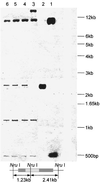Cell wall core galactofuran synthesis is essential for growth of mycobacteria
- PMID: 11395463
- PMCID: PMC95282
- DOI: 10.1128/JB.183.13.3991-3998.2001
Cell wall core galactofuran synthesis is essential for growth of mycobacteria
Erratum in
- J Bacteriol 2001 Dec;183(23):6971
Abstract
The mycobacterial cell wall core consists of an outer lipid (mycolic acid) layer attached to peptidoglycan via a galactofuranosyl-containing polysaccharide, arabinogalactan. This structural arrangement strongly suggests that galactofuranosyl residues are essential for the growth and viability of mycobacteria. Galactofuranosyl residues are formed in nature by a ring contraction of UDP-galactopyranose to UDP-galactofuranose catalyzed by the enzyme UDP-galactopyranose mutase (Glf). In Mycobacterium tuberculosis the glf gene overlaps, by 1 nucleotide, a gene, Rv3808c, that has been shown to encode a galactofuranosyl transferase. We demonstrate here that glf can be knocked out in Mycobacterium smegmatis by allelic replacement only in the presence of two rescue plasmids carrying functional copies of glf and Rv3808c. The glf rescue plasmid was designed with a temperature-sensitive origin of replication and the M. smegmatis glf knockout mutant is unable to grow at the higher temperature at which the glf-containing rescue plasmid is lost. In a separate experiment, the Rv3808c rescue plasmid was designed with a temperature-sensitive origin of replication and the glf-bearing plasmid was designed with a normal original of replication; this strain was also unable to grow at the nonpermissive temperature. Thus, both glf and Rv3808c are essential for growth. These findings and the fact that galactofuranosyl residues are not found in humans supports the development of UDP-galactopyranose mutase and galactofuranosyl transferase as important targets for the development of new antituberculosis drugs.
Figures






References
-
- Besra G S, Khoo K-H, McNeil M, Dell A, Morris H R, Brennan P J. A new interpretation of the structure of the mycolyl-arabinogalactan complex of Mycobacterium tuberculosis as revealed through characterization of oligoglycosylalditol fragments by fast-atom bombardment mass spectrometry and 1H nuclear magnetic resonance spectroscopy. Biochemistry. 1995;34:4257–4266. - PubMed
-
- Curcic R, Dhandayuthapani S, Deretic V. Gene expression in mycobacteria: transcriptional fusions based on xylE and analysis of the promoter region of the response regulator mtrA from Mycobacterium tuberculosis. Mol Microbiol. 1994;13:1057–1064. - PubMed
-
- Daffe M, Brennan P J, McNeil M. Predominant structural features of the cell wall arabinogalactan of Mycobacterium tuberculosis as revealed through characterization of oligoglycosyl alditol fragments by gas chromatography/mass spectrometry and by 1H and 13C-NMR analyses. J Biol Chem. 1990;265:6734–6743. - PubMed
-
- Daffe M, McNeil M, Brennan P J. Major structural features of the cell wall arabinogalactans of Mycobacterium, Rhodococcus, and Nocardia spp. Carbohydr Res. 1993;249:383–398. - PubMed
Publication types
MeSH terms
Substances
Grants and funding
LinkOut - more resources
Full Text Sources
Other Literature Sources

